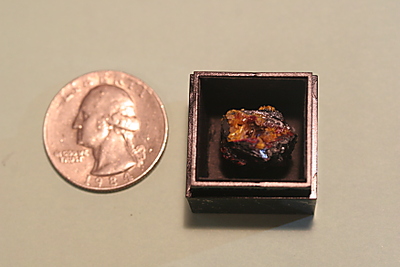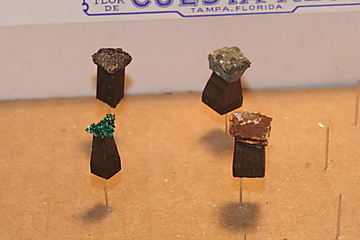
Some people study and collect micro minerals, not making permanent mounts or trimming material to fit in a certain size of box. This is perfectly fine. Such people often like to call themselves "micro mineral collectors" to make it clear that they are not making permanent mounts.
You would be surprised how many spectacular crystals and beautiful
sights are hidden on many seemingly ordinary specimens.
Here are some strong arguments in favor of micromouting:
This is not universally true, but I have noticed that many serious collectors of micro minerals become respectable mineralogists in ways that collectors of larger pieces seldom do. Conversely, many serious collectors of larger minerals end up acquiring a microscope even if they do not become micromounters.
I was given permission to use this article written by Patricia Barker of the Microumounters of New England. It nicely captures the excitement and enthusiasm of someone discovering the world of micro minerals.
You don't want a high powered biological microscope intended for use with transmitted light, but rather a low power stereo microscope (with two eyepieces). You want the kind of thing suited for looking at insects and flowers (and minerals!). The most useful magnification are low powers (10 or 15), with the option to switch to higher power as needed. The scope I use the most is a zoom scope offering a range of powers from 10 to 30. Higher powers are handy on occasion, but require a really good light (and quality optics) to be useful.
I provide some notes on various microscopes which are hardly comprehensive, but may be useful.
Buying a microscope can be an obstacle to some folks, but it really shouldn't be. Even if you are not a micromounter, if you are a serious mineral collector, you need a microscope. A quite good microscope can be purchased for less than what a single decent quality larger mineral specimen sells for these days. (Depending on how you look at this, this is either tragic or wonderful). Some snooping around on Ebay and careful bidding can fetch a person a perfectly fine microscope for less than $300, perhaps much less if you are patient and lucky.
The next purchase, and every bit as important as the microscope itself is a high quality illuminator.
I have some notes on microscope illuminators that you may want to read.
Many parts of the country have a seminar or symposium one a year. Tucson has a one day event on Friday during the Tucson main show. There is one in southern california in January, just a week or two before the Tucson show (those of us who live nearby, prefer it two weeks before, so we can rest up for Tucson, those who live farther away, would prefer to have them close together, so they can travel and attend both events). The Northern California group has an excellent event in the summer (3 days), and the Baltimore group has another 3 day event (and may be the group that originated the concept). The Tucson event is the only one day seminar, and people complain that there isn't enough time for talking and swapping, with most of the time given to lectures.
The micromounting world has a hall of fame. I have had the chance to meet several of these people, and I can simply say that it is worth it to make their acquaintance. This is their passion, and if you show a real interest, they will be eager to help and share, and they have a lot to offer. As much as anything, many were elected to the hall of fame because of their helpful and generous attitudes.
Beware that some dealers who offer micro material think that any crumbs that fall off a larger specimen are "micromounts". Avoid these people. There are other dealers who understand what quality micromount material is.
Buying micro material is a very nice contrast to other parts of the mineral world where big money changes hands and things are getting increasingly insane. The flip side to this is that prices below some level do not encourage dealers to handle micro material. Be willing to pay a decent price for what you get and make it worth a dealers while to do business and spend time with you. Also realize that some dealers love minerals and will be delighted to find someone interested in unusual species.
 Neal Yedlin wrote the original micromounting column in the
Mineralogical Record Magazine. He said that a micromount is a
mineral specimen requiring magnification for proper appreciation,
permanently mounted and labelled. I have noticed that some people
who are enthused about micro minerals are reluctant or even strongly
opposed to permanent mounting. I am a little baffled by this, perhaps
because I understand the ravages of time. Mounting and labelling will
preserve these little treasures, first of all for the mounter to enjoy
in months and years to come (just a few years accumulation of dust,
or a few years lapse of memory can cause real and tragic loss).
To mount is to preserve!
Neal Yedlin wrote the original micromounting column in the
Mineralogical Record Magazine. He said that a micromount is a
mineral specimen requiring magnification for proper appreciation,
permanently mounted and labelled. I have noticed that some people
who are enthused about micro minerals are reluctant or even strongly
opposed to permanent mounting. I am a little baffled by this, perhaps
because I understand the ravages of time. Mounting and labelling will
preserve these little treasures, first of all for the mounter to enjoy
in months and years to come (just a few years accumulation of dust,
or a few years lapse of memory can cause real and tragic loss).
To mount is to preserve!
It recently seems to have become "in vogue" to not make permanent mounts, but instead to simply perch specimens on a dab of "mineral tack" in some kind of box. These can hardly be called permanent mounts and would thus fall short of Yedlins definition of a micromount. This kind of thing may have its place for temporary storage (but the tack can leave a mess and hinder the ultimate preparation of a permanent mount). This should just be called what it is: lazy! and is not to be emulated. Good micros are too fragile, too ephemeral, and deserve to be preserved. That is what permanent labelling and mounting is all about.
Buy and use a good mineral book!Here are a couple of good books to get started with:
The Complete Guide to Micromounts by Milton L. Speckels, 1965, Gembooks, 97 pages. --- This is the little pink book that got everything started (so to speak), now out of print, but you may get lucky and find a used copy.
The Complete Book of Micromounting by Quintin Wight, 1993, First Edition, Mineralogical Record Press, 283 pages --- This book was begun by Neal Yedlin (1908-1977), continued by Paul Desautels (1920-1991) and finished by Quintin Wight. It is by far the best and most up to date thing available in English, although books on micromounting are said to be available in German, French, and Italian.
Supplies
Tom's Mineralogy Info / tom@mmto.org